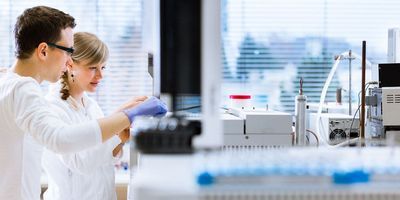Accessible Analytical Methods with Generated Hydrogen
Using hydrogen as the carrier gas in GC-MS
For gas chromatography-mass spectrometry (GC-MS) applications, the selection of helium, nitrogen, or hydrogen as the carrier gas for the mobile phase affects the separation, run time, signal-to-noise ratio, and cost per analysis. For many labs, maintaining low cost per analysis without sacrificing data quality is a top priority. This resource explores the development of a robust, repeatable GC-MS method using hydrogen carrier gas supplied by a gas generator for the analysis of polycyclic aromatic hydrocarbons (PAHs) in water samples.
PAH MONITORING REQUIRES A SENSITIVE, COST-EFFECTIVE METHOD
PAHs are a class of structurally related hydrocarbons, naturally occurring in fossil fuels, bitumen, coal tar pitch, creosote, and raw materials for plastic and rubber manufacturing. PAHs are carcinogenic, and as they bioaccumulate, have adverse effects for aquatic life and humans. There is different legislation for maximal allowable PAH concentrations, and with mounting evidence, these limits are expected to decrease. PAH detection methods must be highly sensitive to detect low concentrations, and offer sufficient speed and throughput to reduce the costs associated with monitoring. In the GC-MS method described here, generated hydrogen gas as the carrier gas offers the speed, separating capacity, and affordability required to make this analytical method more accessible.
THE RATIONALE FOR HYDROGEN
Helium is one of the most common carrier gases used as the mobile phase in GC however it is a limited resource subject to fluctuating costs and reduced availability— especially in developing countries. Hydrogen is becoming more widely used for GC methods. It has been shown to produce a better separation over a larger velocity range, and can result in faster analyses with better signal-tonoise ratios. In general, hydrogen gas is safer than natural gas that is widely used in our homes. Hydrogen generators provide a safe alternative to compressed gas cylinders, as they store very little gas and are designed for automatic shutdown in the event of a leak or overpressure.
A LLE-LVI-GC-MS METHOD FOR THE DETECTION OF PAHs IN WATER
The most common methods for PAH detection combine liquid-liquid extraction (LLE) and GC-MS. For LLE, a large volume injection (LVI) into the GC inlet is an alternative to manual concentration. In this experiment, a PAH stock standard was prepared by diluting the calibration mix in acetone to create a 0.1 μg/ml solution. Internal standard stock was diluted in acetone to create a 0.2 μg/ml solution. Samples, calibration standards, and blanks were prepared with water and pentane, and PAH stock solution was added to create calibration standards at 10, 50, 100, 250, 500, and 1000 ng/l. Following sonication, a portion of concentrated extract was added to an autosampler with the internal standard stock and capped.
A VICI DBS NM Plus hydrogen generator supplied the hydrogen carrier gas for the mobile phase. The GC oven was programmed from 50°C with a two-minute hold, to 340°C at 25°C/minute and held for 0.5 minutes. The method was optimized with the lowest operating temperatures to minimize any reaction with hydrogen. Compounds eluted through a heated transfer line, held at 280°C into the MS, with the ion source set at 230°C and the quadrupole at 150°C. Based on the results, this method demonstrated very good potential in speed and separating capacity. The final target compound eluted in less than 14 minutes, whereas conventional methods require 30-40 minutes. High-purity hydrogen gas supplied by the VICI DBS NM Plus generator produced excellent peak shape and separation, and there were no adverse effects observed concerning the possible reaction of hydrogen carrier gas with analytes or the stationary phase of the GC column. The method is also amenable to modification for greater speed with a higher performance MS vacuum pump, a smaller internal diameter column, and an autosampler for LLE.
VICI LABORATORY GAS GENERATORS
Hydrogen gas generators provide safe, reliable, high-purity gas to support GC-MS. VICI DBS has been specializing in the design, development, and manufacturing of products and accessories for analytical instruments for over three decades. The innovative generator technology is designed to offer unique performance benefits, including guaranteed ultra-high purity gas, silent operation, minimal moving parts, and requires minimal operator attention. Generators are manufactured in an ISO 9001:2015 accredited facility, and meet or exceed requirements for CE, FCC, and MET (CSA and UL compliant). With 12,000 systems installed worldwide, VICI DBS provides reliable hydrogen, nitrogen, and zero air generators for a wide range of GC-MS and LC-MS applications.

